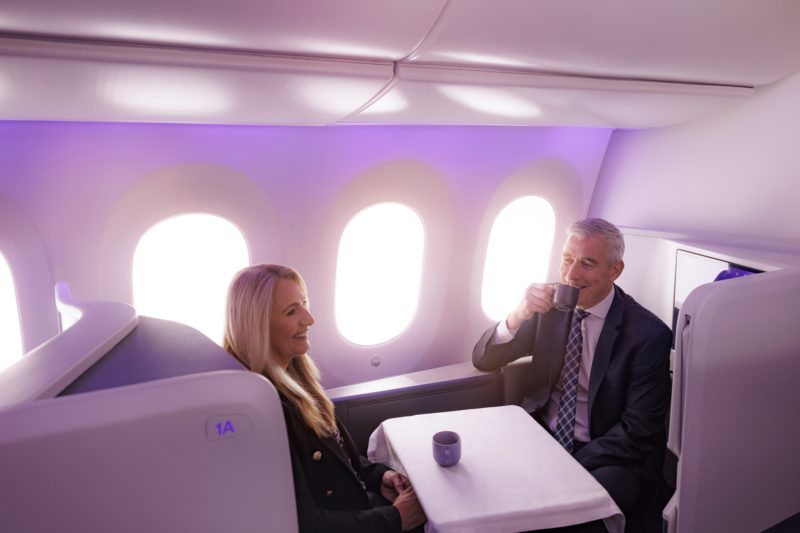After the big news of the SkyNest yesterday, we’re going to focus on the new Business Class seats that Air New Zealand will be flying.
Safran Seats will be the supplier of the new seat for the Boeing 787-9 Dreamliner aircraft to give what Air New Zealand will call “the best sleep in the sky”.
The seats are due to enter service with the updated cabin in 2024.
This seat is specifically designed for Boeing 787 with no compromises and maximizing the available space in this aircraft type. They present two choices within the business premier cabin.
The Business Premier seat offers a comfortable and private nest for passengers to relax in.

If you travelling with a companion, the middle row allows customers to open their space.
The layout will utilise the herringbone configuration of the cabin creates an equal experience for all passengers and helps them have a better sleep with the head of passengers being far from the aisle. To create a sense of privacy, the seats are fitted with high shells combined with adjustable aisle and centre dividers.
Passengers will have access to personal stowage areas that are certified for Taxi, Take-off and Landing as well as multiple surfaces including an electrically assisted large single-piece meal table. The seat will offer wireless charging and an active backrest offering the passenger another way to manage their personal comfort.
Looking at The Business Premier Luxe, this seat is made for passengers who demand space and privacy. A luxury experience with all the features of Business Premier, but with a fully closing door and space for two people to dine.

This premium front row is offered across multiple Safran products in which the layout replaces the traditional front row monuments to provide the utmost privacy and space to the passenger whilst maintaining the same footprint.

This also provides new and enhanced experiences such as welcoming a ‘buddy’ into your suite. For Air New Zealand, this increases the useable space for the passenger by 25%.
How does this all fit aboard a Boeing 787-9?
We’ll go back to the layout of passenger accommodations (LOPA) provided by Air New Zealand. As usual – business class will be at the front of the aircraft.

Depending on the configuration of the aircraft there will be two configurations:
- Long-Haul configuration, made up of 4 Business Luxe, 22 Business Premier, 33 Premium Economy, 213 Economy Class seats, totalling 272 seats
- Ultra-longhaul: 8 Luxe, 42 Business Premier, 52 Premium Economy, 125 Economy Class seats, 6 Skynest bunks, totalling 227 seats and 6 bunks
It would appear the ultra-long-haul variant is very premium heavy to justify putting an aircraft like this on a mission to recover the costs of operating such a flight.
In Quotes
Air New Zealand Head of Aircraft Programmes Kerry Reeves says,
“We really encouraged Safran to think differently and push the boundaries with what we can do with the Business Premier seat the configuration and customer experience. Working virtually throughout Covid added another layer of complexity. Without being able to travel to the Safran site to validate our ideas and concepts, we paralleled the mock-up build both in New Zealand at our innovation lab and at Safran to ensure we had a common design interpretation and valid feedback on the engineering development of the layout and features.”
Vincent Mascré, CEO of Safran Seats, states:
“We are pleased to provide Air New Zealand with a product that meets their needs to offer choice and a product dedicated to ultra-long haul flight. These seats are the fruit of incredible work between our companies and it will allow a better journey for all their passengers. The creation of this seat displays the remarkable capabilities between Air New Zealand and the experienced Safran Seats teams based in United Kingdom”.
The proof is in the long-haul pudding
We’ve looked at the economy product with Skynest – and I can see a point to that product. However, this is targeted at the budget traveller.
We are back in the traditional place of the ultra-long-haul segment – big seats, flat beds and plenty of space to make the experience enjoyable at best, and passable at worst, whilst a limited number of passengers down the back enjoy the economies of 3-3-3 seat layouts.
Ultra-long-haul missions take a toll when in a carbon fibre/metallic ribbed aircraft. Whilst the climate and altitude control makes it a lot better (compared to a Boeing 777 – those can be rough on your skin after 8 hours, let alone the 15 to 18-hour segments that are expected of ultra-long-haul), the well-being of the passengers is going to be something to monitor across the cabin.
With airlines around the world looking at the Ultra-Long-Haul segments with a lot of interest to create point-to-point connections, the cabin is going to be a key part of the mixture if passengers select it and what class they fly in.
All Images, Air New Zealand/Safran Seats.
Welcome to Economy Class and Beyond – Your no-nonsense guide to network news, honest reviews, featuring in-depth coverage, unique research, as well as the humour and madness I only know how to deliver.
Follow me on Twitter at @EconomyBeyond for the latest updates! You can follow me on Instagram too!
Also remember that we are part of the BoardingArea community, bringing you the latest frequent flyer news from around the world.